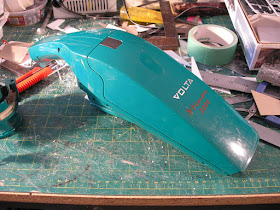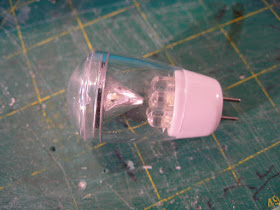I was thinking the first escape pod was a bit oversize and was more aptly described by a member of the RPF forum as a shuttle pod, so I thought this dustbuster could make a one person pod more in keeping with the original intent.
One of the other charity shop finds was a massive pink Barbie Jet Plane (which will become a future project) from which I salvaged the blue engine mouldings which I shortened by removing a section from the middle. The engines are fitted together with a box structure of 2mm styrene at an angle which matches the angle of the lower side of the dustbuster shell which has been gutted of its internals.
Slabs of 10mm and 6mm grey pvc make up the support rod housing underneath and at the rear. A hole was threaded 3/8 whitworth to match the 3/8 whitworth bolt I use as a support rod. Wiring for the engine lights and the cockpit lights is also installed and hooked up to a couple of 12volt DC connectors. The PVC is glued with thick super glue to heavily roughened surfaces.
Some kit part detailing of the back of the engine structure was done.
With all the wiring tested the two halves could be permanently brought together with the aid of the original screws, and the engine assembly glued on with the usual Methylene chloride solvent. The bottom panel of the engine bay was made removable and detailed. You can see the round bottom DC connector next to the support rod access which uses a rectangular hole that already existed in the housing.
Below you can make out the rear DC connector on the right hand side. It should be inconspicuous in amongst the rest of the nurnies.
An oval shaped cockpit window was added. The acrylic sheet clear material was softened with a heat gun and pressed with a cloth pad into the back of the dust compartment access door so that it took on the compound curvature before the hole was cut. It was then glued into position with solvent and masked up both sides. I'm using scotch brand fine edge masking tape here which does as it says, it works very well.
I have also added some fins at the rear. I was toying with some wings of some sort but decided it made it like too "aircraft" like which is not what I want.
I had a search in my local Bunnings hardware store for something suitable for the engine lights and came across these 12 volt HPM brand led garden bulbs. They are designed for multiple fixtures and come apart to be adapted for what ever housing required. They were perfect for what I needed and come with a suitable bell shaped nozzle, I just removed the end lens and the internal reflector which just all press fits together. They also have the standard bi pin connector so I added a couple of the ceramic connectors I have in stock to the rear of the engines and plugged in the lights.
Next up is paneling the hull and a final detailing pass but before that I am going to complete the first escape pod project.
More soon...




















Outstanding as always. I learn so much from your posts. I hope to one day incorporate some of these techniques into my own scratch-builds. Thanks!
ReplyDeleteI think you need to also make some videos of these models with some of your own background music!
ReplyDeleteThis is extremely awesome. Really miss models in films.
ReplyDeleteAny tips on recognizing ABS in the field (ie charity shop)?
ReplyDeleteThanks.
Styrene and ABS have an almost metallic "ring" when tapped, and are hard when a thumbnail is pressed in, whereas polyethylene and polypropylene sound dull, a thumbnail will generally leave a divot and they have a waxy feel to the surface.
ReplyDeleteI just found your blog through the RPF, it's so amazing!! I've already learnt so much.
ReplyDelete